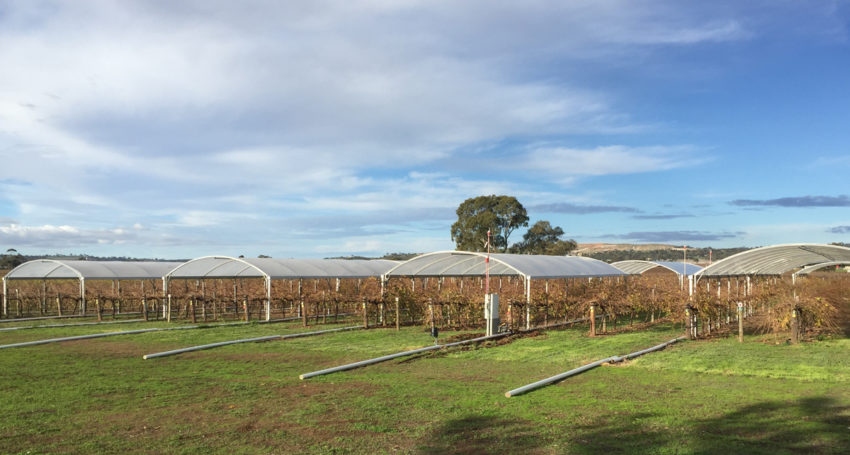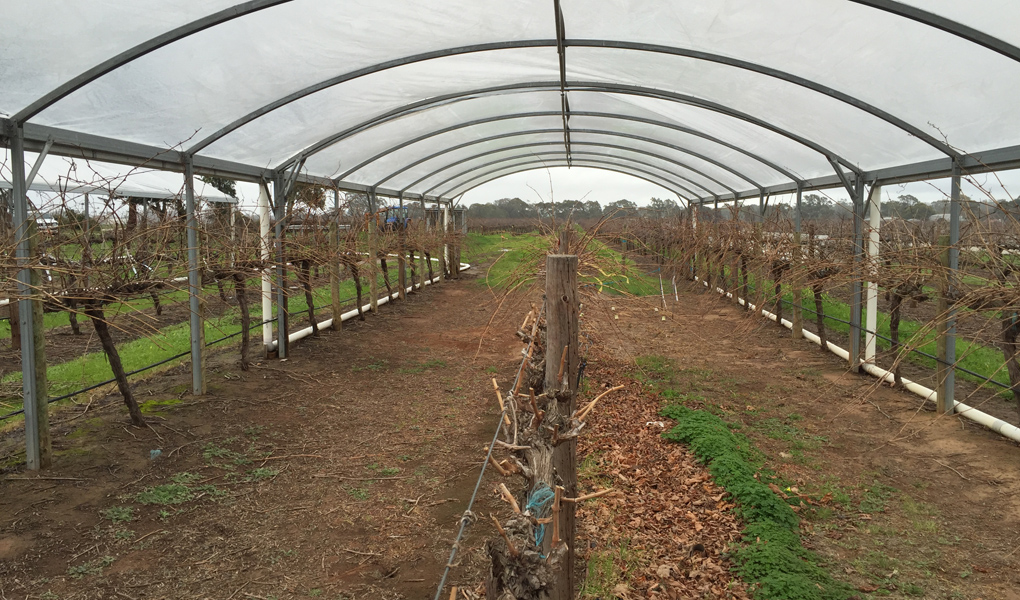Watering dormant vines during winter in dry seasons is far more effective at maintaining yields and quality than waiting until spring, a three-year study in South Australia has found.
Led by the South Australian Research and Development Institute (SARDI) at Waite Campus, in conjunction with the CSIRO and funded by Wine Australia, the study aims to develop strategies to help vignerons combat the dry autumns and winters associated with climate change.

Republished from The LEAD South Australia

In South eastern Australia, where the bulk of Australia’s premium wine grapes are grown, rainfall in autumn and early winter has only reached the long-term average a handful of times in the past 25 years.
South Australia is consistently responsible for about 50 per cent of Australia’s annual production and 75 per cent of premium wine production.
This weather pattern sparked the SARDI project in 2015. Covers were placed over about 120 Shiraz vines in the Barossa between May and early September to mimic drought conditions while another 32 uncovered vines served as the control crop.
The vines under the covers were split into four groups: Those irrigated with long term average amounts of winter ‘rainfall’ in Nuriootpa through under canopy sprinklers; vines given the same 230mm of water through drippers across the winter; a reduced rain group that received only a third of the water of the other two, and; a spring rain set of vines subjected to a dry winter followed by 150mm of irrigation to refill the soil profile as the covers were removed just before budburst in early September.
The uncovered control crop performed best overall, averaging 10.86kg per vine over the three years. The sprinkler-irrigated vines (10.06kg) were next followed closely by the dripper-fed vines (8.95kg). The reduced rain vines had two poor years and one excellent season following strong rains either side of winter in 2016, bumping the average fruit yield up to 9.02kg per vine over the three years. But the surprise result was the consistently poor performance of the vines left dry in the winter but pumped full of water in September, which averaged 8.48kg per vine.
Project leader Dr Marcos Bonada, based at Waite Campus, said these particular spring-watered vines put on a lot of canopy growth following the heavy irrigation but did not match it with fruit production. He said sensory testing of the wine made using grapes from these vines also had the most undesirable elements of the five groups.
“Australian vineyards in traditional regions rely on starting spring with a full soil water profile and that sustains the growth of those vines for a good part of the summer,” Dr Bonada said. “Everyone’s been pretty aware of the need for winter rainfall and the importance of having a full profile but nobody has really said what do we do about it because 95 per cent of the time we had a full profile so it wasn’t that big a deal. But now with climate change we’re seeing a lot less rain and especially less rain during autumn and winter.”
The trial wine from the 2018 vintage has recently been bottled ahead of a sensory assessment in November and a final report is being prepared for Wine Australia.
Dr Bonada said one of the biggest findings in the trial was the detrimental effect of holding back winter irrigation in dry years until spring.
“When we irrigated the vines in the spring time, which is more like what a grower would typically do following a dry winter, there were decreases in yield and a detrimental effect on wine sensory profile,” he said. “That was the worst outcome because you were refilling the soil water profile in spring as opposed to during winter but you were always having a reduction in yield and we always grew a much larger canopy so the quality of the grapes wasn’t as good as well – it tended to grow a whole lot of leaves instead of fruit bunches.”

The researchers say the benefits of the winter watering in dry years far outweighed the cost of the additional water and associated expenses, particularly in regions such as Barossa where Shiraz grapes fetched about $2250 a tonne.
Wine Australia has funded a second phase of the study, which began at the same Nuriootpa research vineyard this year.
The second phase includes a second row of drip irrigation – either side of the vine – to enable broader watering in an attempt to bridge the gap between the yields of sprinkler fed vines and drippers. The project will also water further into spring beyond budburst to better gauge the interaction with the spring rain.
“At the moment that’s the real take home message – if you’re having a dry winter you want to be putting the water on during the winter despite the vines being dormant. Don’t wait until spring because then you’re just going to grow a big canopy and not have as much fruit.”
There are 18 wine regions in South Australia, including the Barossa Valley, Clare Valley, Coonawarra, Adelaide Hills, Langhorne Creek, McLaren Vale, Limestone Coast and Riverland.
More than 200 cellar doors are within an hour’s drive of the city centre of Adelaide.
